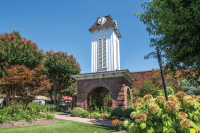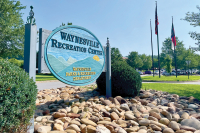Recession be damned: Waynesville stands behind nonprofit contributions
 To some, they might seem like pet projects, budgetary fat in tough times, or frivolous earmarks.
To some, they might seem like pet projects, budgetary fat in tough times, or frivolous earmarks.
But Waynesville leaders are defending $100,000 in annual contributions to a slate of 30 nonprofit organizations as a form of economic development, community advancement and social uplift.
The contributions come in spite of budget shortfalls prompting a 3-cent property tax increase by the town.
“Even in times when we are having to make these very difficult decisions, I think it is important we support those good things in our community,” said Alderman Wells Greeley. “As town leaders we have an obligation to support and recognize their valuable contributions.”
The vast majority of nonprofits helped by the town provide social welfare services, including REACH domestic violence agency, KARE child abuse task force, Meals on Wheels, Open Door Soup Kitchen, Good Samaritan Clinic, the Red Cross and the Salvation Army.
“These are needs in the community that the government would have to address as problems and challenges if the nonprofits weren’t doing it,” Greeley said.
Related Items
Despite the social and civic role of nonprofits, Haywood County commissioners summarily cut all nonprofit contributions across the board when the recession first hit in 2008. Targeted as low-hanging fruit during tight budget times, commissioners have yet to restore the nonprofit funding stripped from the county budget.
But that’s not a philosophy shared by Waynesville leaders.
“We could say we aren’t going to give anything and just hunker down. But these groups are striving to make the quality of life better,” Greeley said.
The town was asked for $150,000 in nonprofit contributions this year but only had $100,000 to go around. Alderman Gary Caldwell takes on the annual task of putting pencil to paper and recommending what the town should give out.
“I try to spread it around since a lot of nonprofits are struggling with losing money from other sources,” Caldwell said. “The county doesn’t give anything anymore. We are about the only ones around that do what we can to try to help the nonprofits. It’s not a lot, but it does it help.”
Alderwoman Julia Freeman, who is also the executive director of the REACH domestic violence nonprofit, said her agency saw $24,000 in annual funding cut by the county several years ago.
“These services sometimes aren’t very pretty. They are dealing with child abuse and domestic violence or homelessness and people who are hungry,” Freeman said. “They provide central services in our communities.”
Only a few of the town’s nonprofit contributions fall into the cultural category, like the Haywood Arts Council, the Waynesville Public Art Commission or the N.C. Handicrafts Museum at the Shelton House.
Capital campaigns
Along with its standard suite of nonprofit funding, the town set aside money for a trio of new grants totaling $75,000 in the coming year. All involve capital campaigns for building projects, including:
• $25,000 for a second theater venue for Haywood Regional Arts Theater.
• $25,000 toward renovating the old Hazelwood school to serve as a community civic center under the auspice of Folkmoot International Folk Festival.
• $25,000 to convert an old, shut-down state prison into a homeless shelter, soup kitchen and half-way house spearheaded by a faith-based community coalition.
“You can’t disassociate these from the economic benefit that is derived from it,” Alderman Leroy Roberson said.
Only HART was awarded funding outright. The other two grants will be held in contingency, to be released if and when the projects reach a more definitive stage.
Winning hearts and minds
Economic impact was a key component of the pitch by HART for a capital contribution toward a second theater venue, which carries a total price tag of more than $1 million, coming primarily from private donations.
“We are the number one attraction in Waynesville,” Steve Lloyd, HART’s director, told the town during a funding pitch earlier this year. “This is one of our community’s assets, and this is an investment in the growth of that asset.”
With a second venue, HART can run shows in a more continuous fashion, with one in rehearsal while another is in production.
“This makes it possible for us to be going all the time,” Lloyd said. “It turns us more into what Flat Rock Playhouse is for Flat Rock.”
The new Fangmeyer Theater, named for its biggest donors, is designed as a flexible event space, hosting not just plays but also dances and receptions. It will have an outdoor amphitheater for concerts, a café bistro and public restrooms that will be open during the bustling Historic Haywood Farmer’s Market, which is held in HART’s parking lot twice weekly.
The HART project easily won approval, unlike the other two capital requests that were met with slightly more pause.
That’s because HART’s project is further along, aldermen said. HART has architectural plans in hand, has already met 75 percent of its fundraising goal, and has a bank loan in place to fund construction, which is slated to start in coming weeks, according to Lloyd.
Reinventing Folkmoot
The town board was not so quick to sign off on a capital campaign contribution for Folkmoot, a signature international folk festival based in Waynesville. Folkmoot plans to renovate the former Hazelwood Elementary School that serves as its headquarters.
The site provides critical lodging for 250 performers during Folkmoot’s two-week festival run in July, but it is old and run down. If renovated, it could realize untapped potential as a year-round civic venue, which would in turn transform Folkmoot’s role and presence in the community.
But Mayor Gavin Brown questioned a $25,000 allocation in the absence of a clear vision for the facility.
“They haven’t come forward with a plan other than try to make the building functional. After we rehabilitate it, then what are we going to do?” Brown asked during a town budget workshop two weeks ago. “To say we are willing to contribute $25,000 to whatever plan they come up with — I would rather take it out.”
Tom Eizell, a Folkmoot volunteer in attendance at the budget workshop, stepped forward to defend the request.
“Folkmoot is moving from what had been a two-week summer festival into a year-round community center for a variety of yet-to-be-determined activities, events, speakers, you name it,” he said. “There is no better time to invest in Folkmoot than now.”
A master plan will be shaped in coming months through a community input and visioning process.
“We don’t have the plan yet,” Eizell admitted. “That needs refinement. But they have the brains to put together a plan that will make a definable difference in this community.”
Libba Feichter, a former alderman, supporter of the arts and retired teacher, also spoke up, citing the importance of saving the old school that would otherwise become an abandoned, run-down eyesore and liability.
“What would happen to that building if not for Folkmoot? It would become derelict,” Feichter said. “It is a building that should be treasured and secured for the use of the community.”
Folkmoot has put nearly $1 million into renovations, repairs and maintenance of the old school over the past decade already, but there is still a long way to go — from the dire and immediate need for a new roof to restoring the old auditorium into a functional performance space.
Waynesville Alderman Leroy Roberson suggested the town include the Folkmoot grant as a contingency budget item.
“Not just cast it aside and think about it later. Let’s put it in there as favorable toward Folkmoot. Once we get the plan and see something definitive, then we can act on it,” Roberson said.
As other aldermen nodded in agreement, Brown acknowledged he was outnumbered.
“OK, let’s see if they can earn their way toward that $25,000,” Brown said.
The town was paid a visit at its meeting the following week by Rose Johnson, the president of the Folkmoot board, to articulate and expound on Folkmoot’s idea for the facility.
“You are starting to see a plan develop to utilize a building that would otherwise be empty for many, many years,” Freeman said. But, “They are still in the infancy stage and figuring out what this will entail.”
The town ultimately awarded Folkmoot a $5,000 grant to aid with a design plan, with the rest parked in contingency.
A helping hand
The third project seeking a $25,000 grant from the town is an initiative to convert a closed-down state prison in Hazelwood into a halfway house and homeless shelter under the auspice of Haywood Helps. A coalition of churches have joined forces to pull off the project, aimed at transforming and rebuilding lives of the down-trodden.
“That is going to be a plus for our community,” Alderman Caldwell said.
But as with Folkmoot, town leaders questioned whether the project was far enough along to warrant cutting a check yet. The board decided to set aside the money “in holding,” Caldwell said.









